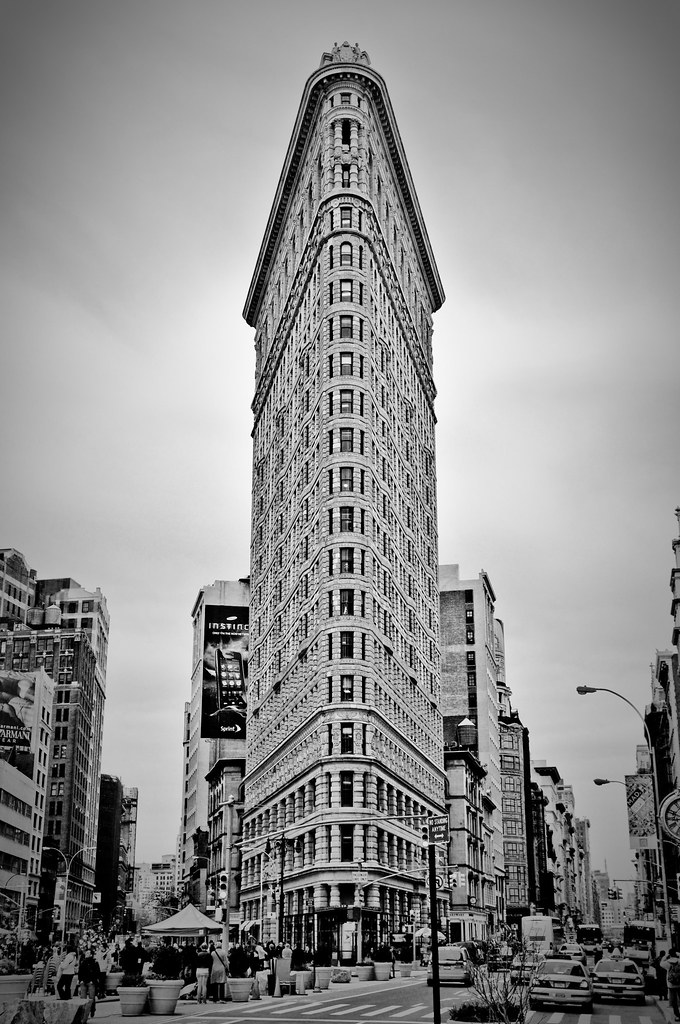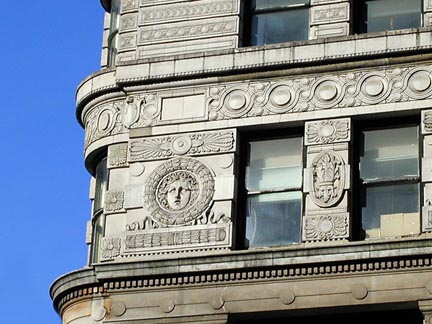
The distinctive triangular shape of the Flatiron Building, designed by Chicago architect Daniel Burnham and built in 1902, allowed it to fill the wedge-shaped property located at the intersection of Fifth Avenue and Broadway. The building was intended to serve as offices for the George A. Fuller Company, a major Chicago contracting firm. At 22 stories and 307 feet, the Flatiron was never the city's tallest building, but always one of its most dramatic-looking, and its popularity with photographers and artists has made it an enduring symbol of New York for more than a century.
When the Flatiron Building first opened, female tenants were at a
disadvantage, as the building's designers had failed to include any
ladies' restrooms. Management had to designate bathrooms for men and
women on alternating floors.

Plans for Construction
Though the Flatiron Building is often said to have gotten its famous name from its similarity to a certain household appliance, the triangular region contained by Broadway, Fifth Avenue, and 22nd and 23rd Streets had in fact been known as the "Flat Iron" prior to the building's construction. The brothers Samuel and Mott Newhouse, who made their fortune in the mines of the West, bought the property in 1899. At the time, efforts were being made to create a new business district in New York, north of the current hub of Wall Street. In 1901, the Newhouses joined a syndicate led by Harry S. Black, head of the George A. Fuller Company, and filed plans to build a 20-story building on the triangular plot.The Flatiron Building would not be the tallest building in the city--the 29-story, 391-foot Park Row Building that had gone up in 1899 already held that spot. But its design by Daniel Burnham, a member of the prominent Chicago School of architecture, would make it one of the most unusual looking of the steel-framed skyscrapers being constructed at the time. (The first of these was the Home Insurance Building in Chicago, which had been completed in 1885.) Whereas many of the new tall buildings featured high towers emerging from heavy, block-like bases, Burnham's tower soared directly up from street level, making an immediate and striking contrast against the lower buildings surrounding it.

"Burnham's Folly"?
This characteristic of the Flatiron Building's design--its look of a freestanding tower--initially inspired widespread skepticism about whether it would actually be stable enough to survive. Some early critics referred to "Burnham's Folly," claiming that the combination of triangular shape and height would cause the building to fall down. Newspaper reports at the time of the building's completion focused on the potentially dangerous wind-tunnel effect created by the triangular building at the intersection of two big streets.Despite these critiques, crowds gathered around to gawk at the Flatiron Building when it was completed, and in the ensuing years it became a frequent sight in photographs, paintings and postcards and one of the most popular symbols of New York City itself. Photographers Edward Steichen and Alfred Stieglitz captured particularly memorable images of the building, as did the impressionist painter Childe Hassam.

An Enduring Icon
Built around a skeleton of steel, the Flatiron Building is fronted with limestone and terra-cotta and designed in the Beaux-Arts style, featuring French and Italian Renaissance influences and other trends seen at the 1893 World's Columbian Exposition. Shaped like a perfect right triangle, it measures only six feet across the narrow end.The Fuller Company moved out of the building in 1929, and for years the area around the Flatiron Building remained relatively barren. Beginning in the late 1990s, however, building's enduring popularity helped drive the neighborhood's transformation into a top destination for high-end restaurants, shopping and sightseeing. Today, the Flatiron Building mainly houses publishing businesses, in addition to a few shops on the ground floor.
They'd never put that kind of workmanship in a building today!
ReplyDeleteI know, I think all that stone carving is a lost art. Darn shame. I love all the architecture on all the classic buildings. New York has so many treasures, but no one looks up to see them all.
DeleteWe've torn most of ours down locally. Our local politicians wanted a modern city, so they tore the old stuff down. Unfortunately, no-one wanted to rebuild downtown, so we now have office buildings and parking lots and nothing else.
ReplyDeleteIt is so sad that these magnificent older buildings are being torn down to make way for square cement blocks with windows. I wish they would modernize the interiors and keep the charming facades of a by-gone era. People would flock to stores that have character. How many times have you walked into an old store and felt you were transported back in time? I know I have and spent my money there, too! Politicians always want to change things and it's not always for the better.
Delete